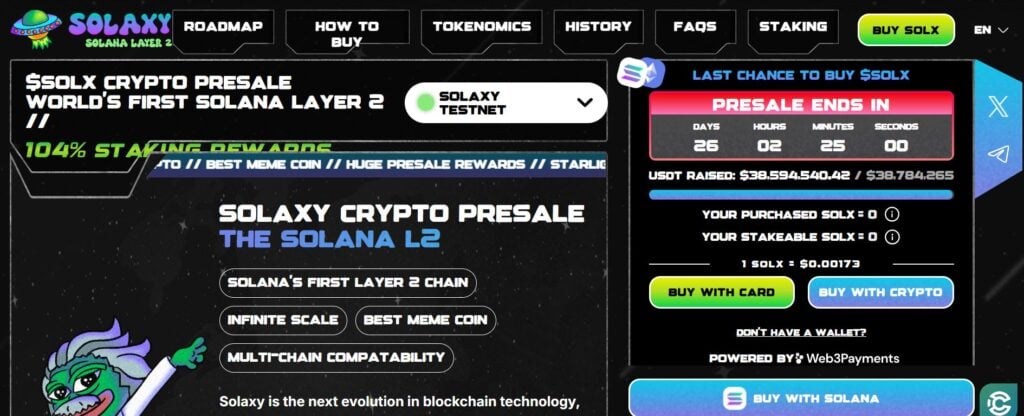- The Solaxy token is powers the Solaxy L2 chain, which is purpose-built to enhance transaction speed, reduce congestion and support dApps.
Solaxy, the Solana-based Layer 2 project behind the SOLAXY token, has raised $38.7 million in its presale as of this writing. That fete has made it one of the most successful presales in the crypto market in 2025, with 26 days to go. The project is currently offering 104% reward for staking, which has proven to be a key incentive for early investors.
Being an L2 solution is unique selling point for Solaxy, because that is rare for the Solana ecosystem. However, with tens of meme coins launching on the Solana blockchain, congestion is increasingly becoming a reality. Therefore, Solaxy offers a way out by enabling fast transactions, enhancing scalability, especially during bull markets and airdrop events.

How Does Solaxy Work?
Solaxy handles transactions differently from L1 layer. It processes transactions off-chain and bundles them together for confirmation on the L1 mainnet, reducing congestion, and ensuring faster transactions without compromising security. Also, it will lower the cost of transactions on Solana significantly.
In addition, Solaxy is also designed to enable developers to build decentralised applications, creating a pathway to enter markets beyond CEXs and DEXs, including DeFi, GameFi and NFT. Furthermore, the project will support cross-chain interoperability with Ethereum and already has a testnet bridge in place.
The testnet bridge was launched on May 15 and currently enables transfer of SOLAXY tokens between Solana Devnet and Solaxy Testnet. Once it becomes fully operational, it will open SOLAXY token a broader market, which augurs well for its performance once the presale ends.
SOLAXY price is currently at $0.00173 during the presale. Notably, whale activity has contributed significantly to the presale success. A potential downside to the presale is that users who buy the token will have to wait until the presale ends for the tokens to be credited to their wallets. That could potentially dissuade some potential investors and slow down the move towards the $74 million ultimate presale fund target.
This article was originally published on InvestingCube.com. Republishing without permission is prohibited.


